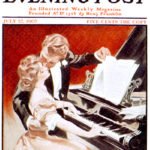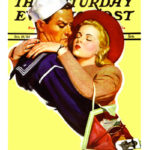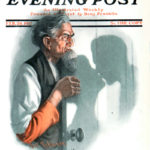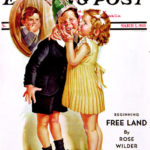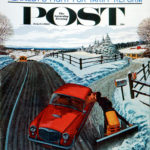Celebrate Women Artists: Sarah Stilwell-Weber
Sarah Stilwell-Weber was one of The Saturday Evening Post’s most sought after artists. She even turned down Post editor George Horace Lorimer’s offer to have regularly scheduled pieces because she didn’t want to work on another’s deadline. Between 1904 and 1925, her work was featured on over 60 covers of both the Post and The Country Gentleman (a sister publication of the Post).
A student of famous illustrator Howard Pyle and the Drexel Institute in Philadelphia, one of the top art schools in the country, Stilwell-Weber captured a lighter side of the Victorian Era and the early 20th century in her work. Her young subjects were often on the move, playing games and exploring the world around them. Her mentor, Howard Pyle, told her never to marry, as it would interfere with her artistic life. However, she ignored him and married anyway.
While the children are forming their own marching band, Mom and Dad wonder if Santa takes returns.
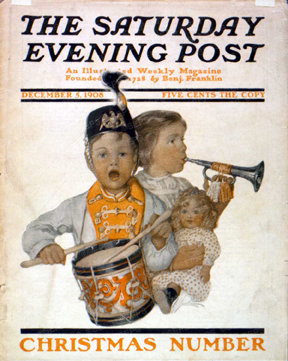
Sarah Stilwell-Weber
December 5, 1908
Forget flower crowns, these girls made a flower cape for their May Day parade grand marshal.
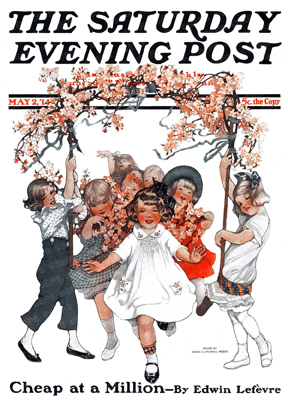
Sarah Stilwell-Weber
May 2, 1914
Is there anything better than splashing in waves, soaking up sun, and building sand castles?
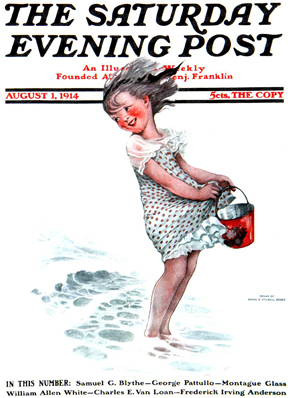
Sarah Stilwell-Weber
August 1, 1914
In the early 1900s, the Post covers were printed with a “duotone” two-color process: black and another color, usually red. This process is what makes the umbrella, flowers, and rosy cheeks on this little girl and her doll pop.
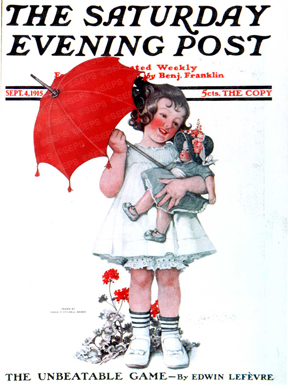
Sarah Stilwell-Weber
September 4, 1915
House cats are just too tame. This stylish young woman dared to make a leopard her pet.
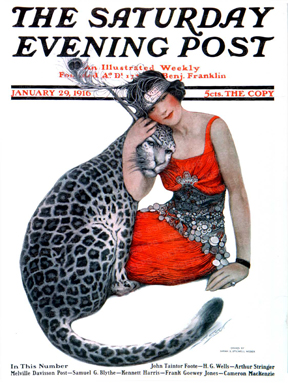
Sarah Stilwell-Weber
January 29, 1916
While many Post covers just show portraits of pretty young women, Stilwell-Weber adds life and movement to the traditional medium. This woman joins in the children’s fun after a stray snowball almost hits her.
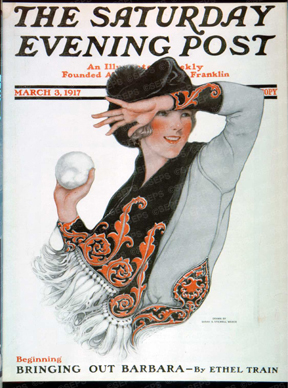
Sarah Stilwell-Weber
March 3, 1917
Rolling her way straight into your heart, this tot on wheels is ready for a hug.
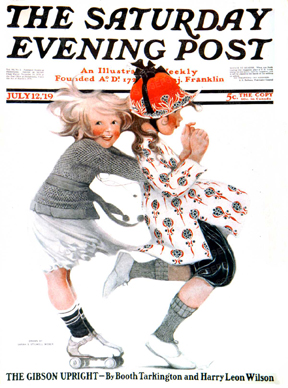
Sarah Stilwell-Weber
July 12, 1919
With that mischievous grin, this little one could be gathering momentum to jump or complete a loop-de-loop over the tree branch.
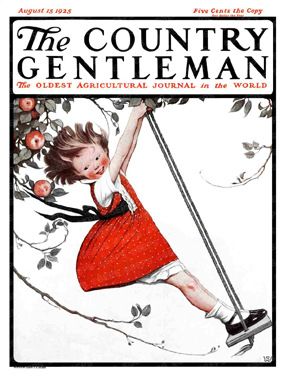
Sarah Stiwell-Weber
August 15, 1925
Hospice Girl Friday | ‘When a Child is Terminally Ill’
Devra Lee Fishman’s dear friend and college roommate, Leslie, died from breast cancer one month shy of her 46th birthday after a four-year battle with the disease. Being with Leslie and her family at the end of her life inspired Devra to help care for others who are terminally ill. Each week, she documents her experiences volunteering at her local hospice in her blog, Hospice Girl Friday.
My mom called me over the weekend to tell me about Kelly, her manager’s daughter. “She finally died, after twenty round of chemo and 5 surgeries,” my mom said, with an audible exhale full of sadness. “At one point they even removed one of her kidneys. Poor little thing.”
I had never met Kelly, but I felt like I had since my mom and I had talked about her so much over the two years since Kelly had been diagnosed with neuroblastoma, a dangerous yet common childhood cancer. That was right after her third birthday and right around the time most three-year-olds are learning to catch a ball and ask important questions like ‘Why is the sky blue?’
My mom thought that Bob, her manager, avoided confrontation at any cost, and she was frustrated by the way some of her co-workers seemed to take advantage of him on a regular basis. But when Bob came back from a long absence and told his team that little Kelly had cancer, my mom changed her attitude. After that, whenever my mom complained about work all I had to say was “Yes, but his daughter has cancer,” and her frustrations about Bob melted away into compassion.
“How is Kelly doing these days?” I’d ask.
“She’s on a new chemo that is making her sick, but Bob said they are going to stick with it. I hope they’re not chasing rainbows.”
“Mom, I can’t imagine what they’re going through. It must be impossibly difficult for everyone.”
“You’re probably right, but I just feel so bad for the little girl. She is sick all of the time from the chemo treatments. They keep taking her up to New York for surgeries. When does she get to be a kid?”
“I think Bob and his wife are trying to make sure she gets to be a kid. And a teenager. And a grown-up. How does a mother give up on her child’s future? You never would have been able to when we were little. You wouldn’t even now that we’re all grown.”
“Of course I wouldn’t,” my mom said without hesitation. “I just feel so badly for that little girl.”
There is a natural order to life: we are supposed to outlive our parents. It was my mother who first pointed that out to me when my friend Leslie was told there were no more treatments available to try to beat her cancer. Leslie’s parents were with her when she died a month shy of her 46th birthday. They are still outliving her.
I do not have kids so I know I will never understand how a parent might feel at any and every stage of a child’s life. But I have watched my own parents’ hearts soar with every high and break with every low that one of my brothers or I experienced. No one in my family has ever had to go through what Bob and his wife went through with Kelly (knock on wood), but I asked my brother David what he would have done if one of his now-grown sons was diagnosed with cancer at a young age. Would he let his child have some quality of life, or would he chase a cure?
“I would pursue every possible treatment, making any sacrifice necessary, even if it meant risking my own health and well-being,” David said. “Not doing so would not even enter my mind. Your thought of providing some quality of life is a consideration, but not at the expense of finding a long term solution or cure.”
David’s answer did not surprise me. My guess is my other brothers, who have two kids each, would say the same.
My hospice is for adults only so I have no experience with parents choosing–or not choosing–hospice care for their children. Still, most of the patients I see did not choose comfort care for themselves. They are in hospice because they exhausted all curative treatments available to them. Some patients have accepted their fates (not all loved ones have, however). Others are in denial or angry at the world or their god or their bodies for being so unfair. Modern medicine has done wonders to keep us alive longer than ever before, but now we are so ill-prepared to face death I often wonder if I would choose to forgo treatments that might prolong my life yet make me so sick I would not enjoy living, or if I would prefer to make the most of whatever time I might have left.
If I think I would have trouble making that decision for myself, I cannot begin to understand how Kelly’s parents could make any other decision than the one they did for their little girl. It’s a decision they will sadly have to live with–without her–for the rest of their lives.
Previous post: Discussing Your Advanced Medical Directive Next post: Getting too close to a terminal patient
Norman Rockwell’s April Fools Covers
After six grueling months of hard work on his famous Four Freedoms, Rockwell did a whimsical cover to relax. Although lighthearted in nature, Rockwell’s 1943 April Fools cover still features the painstaking amount of detail for which the artist was known, packing odd and amusing details into almost every square inch. The cover concept proved so popular with readers that Rockwell did two more such April covers for that decade, in 1945 and 1948. Today, readers still delight in scrutinizing these covers—and even find new errors from time to time. Can you spot all of them?
If you would like to enlarge a cover, click on its image below.
April 1943
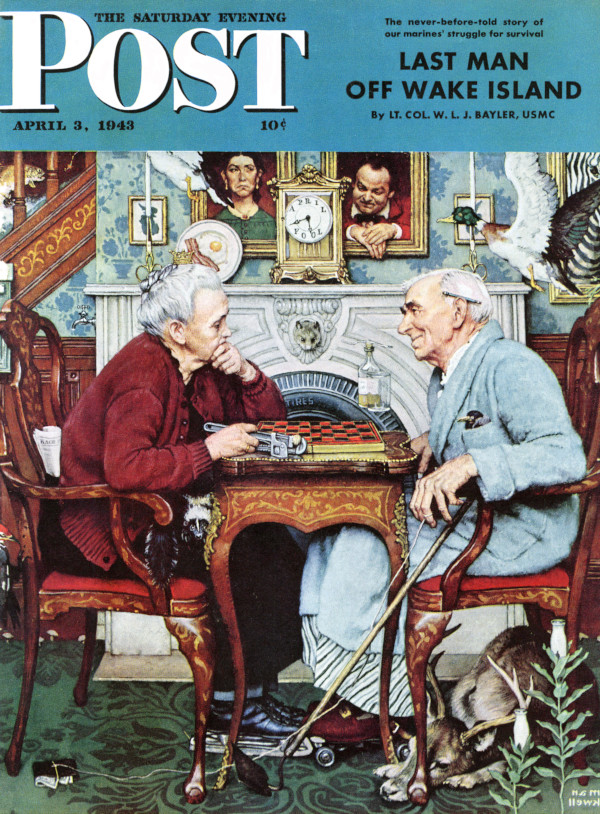
Norman Rockwell
April 3, 1943
(Click to Enlarge)
- The principal April fooleries in the painting are.
- The trout, the fishhook and the water, all on the stairway.
- The stairway running behind the fireplace, an architectural impossibility.
- The mailbox.
- The faucet.
- Wall-paper upside down.
- Wallpaper has two designs.
- The scissors candlestick.
- Silhouettes upside down.
- Bacon and egg on the decorative plate.
- The April-fool clock.
- The portraits.
- Ducks in the living room.
- Zebra looking out of the frame.
- Mouse looking out of the mantelpiece.
- A tire for the iron rim of the mantelpiece.
- Medicine bottle and glass floating in the air.
- Fork in-stead of a spoon on the bottle.
- the old lady’s hip pocket;
- The newspaper in her pocket.
- Her wedding ring on the wrong hand.
- Buttons on the wrong aide of her sweater.
- Crown on her head.
- Stillson wrench for a nutcracker in her hand.
- Skunk on her lap.
- She is wearing trousers.
- She has on ice skates.
- No checkers on checkerboard.
- Wrong number of squares on checkerboard.
- Too many fingers on old man’s hand.
- Erasers on both ends of his pencil.
- He is wearing a skirt.
- He has a bird in his pocket.
- He is wearing roller skates.
- He has a hoe for a cane.
- Billfold on string tied to his finger.
- Milkweed growing in room.
- Milk bottle on milkweed.
- Deer under chair.
- Dog’s paws on deer.
- Mushrooms.
- Woodpecker pecking chair.
- Buckle on man’s slipper.
- Artist’s signature in reverse.
March 1945
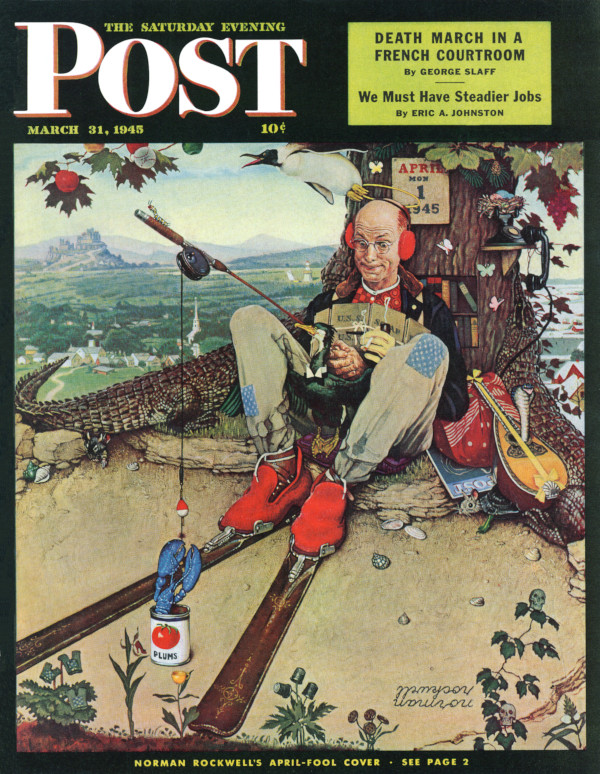
Norman Rockwell
March 31, 1945
(Click to Enlarge)
- Apples on maple tree.
- Different-color apples.
- Baseball among apples.
- Pine boughs.
- Pine cone sh
- ould point down under bough.
- Horse-chestnut leaves.
- Grapes.
- April 1st comes on Sunday, not Monday.
- Penguins don’t fly.
- Halo.
- Nest on phone.
- Different-color eggs.
- Phone wire on wrong end of receiver.
- Different or wrong color butterflies.
- Books on tree.
- Castle in landscape.
- Lighthouse and ship.
- Earmuffs.
- Fur collar on velvet jacket.
- Two different designs on shirt.
- Shirt buttoned wrong way.
- Life jacket.
- Three hands.
- Cigarette and pipe used at same time.
- Collar and necktie on bird.
- Fly-casting reel on bait-casting rod.
- Cloth patches on waders.
- Rod upside down.
- Alligators as roots.
- Cobra in mandolin.
- Ribbon on mandolin.
- Post heading on wrong side of magazine.
- Snow scene.
- Horizons different on two scenes.
- Horns on mouse’s head.
- Animal head on turtle.
- You’re wrong; there are blue lobsters although they are
- extremely unusual freaks of nature.
- Tomato picture on plum can.
- House slippers on skis.
- Shells.
- Dutchman’s-breeches.
- Lady’s-slipper.
- Buttercup.
- Thimbleweed.
- Bachelor-buttons.
- Poison ivy.
- Signature upside down.
- Skis without backs.
- Lead sinkers on line should be below floater.
- Floater upside down.
- Red should be at top of floater in right position.
April 1948
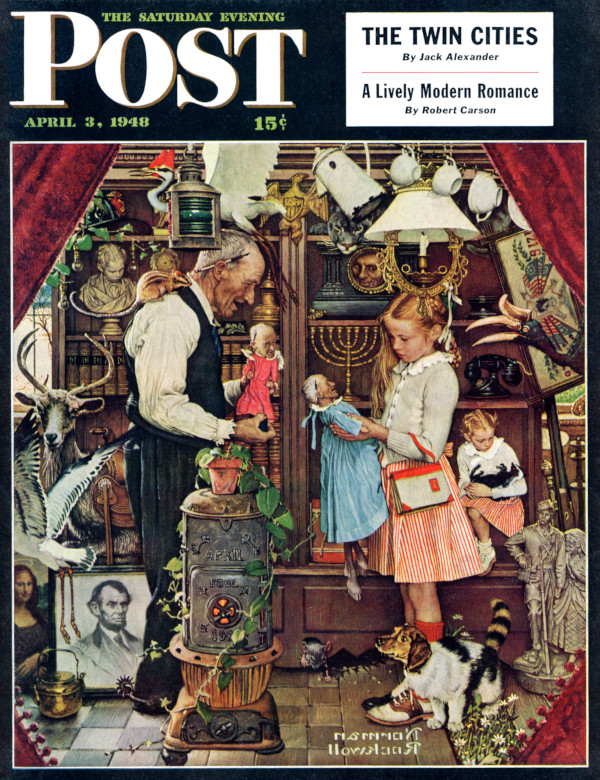
Norman Rockwell
April 3, 1948
(Click to Enlarge)
- Two kinds of molding on cupboard.
- North American Pileated Woodpecker head on crane’s body.
- Coffeepot spout upside down.
- Barbed wire instead of clothesline.
- Insigne on back of fireman’s helmet.
- Green and red lights re¬versed on ship’s lantern.
- Beast crouched on upper shelf.
- Cup not hanging by handle.
- Electric bulbs growing on plant.
- Head of little girl on man’s bust.
- Rat’s tail on chipmunk.
- Penholder with pencil eraser.
- Top of brass vase suspended.
- Face in clock.
- Candle where kerosene lamp should be.
- Sampler dated 1216.
- Winter seen through left window, summer through right.
- Antique dealer’s head on dolls.
- Nine branches on traditional seven-branch candelabra.
- Girl’s hair in pigtail on one side, loose on other.
- Titles on books vertical instead of horizontal.
- Girl’s sweater buttoned wrong way.
- Mouthpiece on both ends of phone.
- Phone not connected.
- Goat’s head, deer’s antlers.
- No shelf under books.
- Lace cuff on man’s shirt.
- Five fingers and thumb on girl’s hand.
- Gun barrel in wrong place.
- Saddle on animal.
- Potted plant on lighted stove.
- Girl’s purse is a book.
- Only half a strap on girl’s purse.
- Skunk in girl’s arms.
- Sea gull with crane’s legs.
- Stovepipe missing.
- Mona Lisa has halo.
- Mona Lisa facing wrong way.
- Abraham Lincoln with General Grant’s military coat.
- Stove has April Fool on it.
- Hoofs instead of feet on doll.
- Little girl sitting on nothing.
- Rogers group is combination of soldier from “Our Hero” and girl from “Blushing Bride.”
- Brass kettle has two spouts.
- Spur on antique dealer’s shoe.
- Mouse and ground mole conferring.
- Ground mole’s tracks in wooden floor.
- Dog’s head on cat’s body.
- Raccoon’s tail on eat’s body.
- Ball fringe standing straight up at angle.
- Stove minus one leg.
- Two kinds of floor.
- Signature reversed.
- Last name spelled wrong.
- Flowers growing in floor.
- Girl’s socks don’t match.
Classic Covers: A Kiss is Just a Kiss
Are you ready for the passionate kiss appearing on the cover of the Post in … are you ready … 1907? The beautiful painting by Frank X. Leyendecker (brother of renowned artist J.C. Leyendecker) shows a beautifully dressed couple at the piano, carried away by the music, one supposes.
Covers from both world wars often depicted heartbreaking scenes of kissing a lover goodbye, but there was a twist to artist John Newton Howitt’s October 19, 1940, cover. The sailor is just about to kiss the pretty girl in his arms, when oops! Her purse opens, and a loving photo of a soldier springs into view. Perhaps she has a military beau in every port? Or maybe it’s her brother … yeah, that’s it.
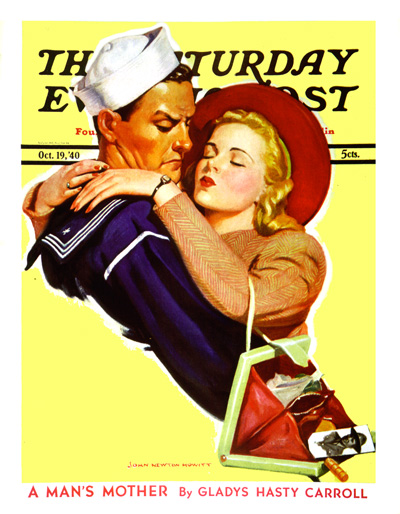
Not everyone approved of this kissing stuff. Robert Robinson was a cover artist in the early 1900s who was gifted at painting what we gently refer to as “old geezers.” This particular old salt sees the shadows of a kissing couple, one of whom is probably his little girl. The young man might want to hurry his “good night” along.
We not only approve, we simply cannot resist this 1938 Post cover by Frances Tipton Hunter. The little girl (who bears a resemblance to Shirley Temple) decides the best way to celebrate her friend’s birthday is with a smooch. We can’t quite tell if the birthday boy likes or dislikes the “gift,” but the boy witnessing the scene is sure getting a kick out of it.
We end with a unique winter scene from 1962 by an artist named James Williamson. An industrious wife is clearing the driveway of snow, and hubby shows his appreciation as he leaves for the office. If you look carefully, you’ll discover a witness to this lip action as well. A tiny squirrel perched atop the snowy fence by the mailbox is wondering what the heck these humans are up to now.
Gallery
by Frank X. Leyendecker
July 27, 1907
by John Newton Howitt
October 19, 1940
by Robert Robinson
February 24, 1917
by Frances Tipton Hunter
March 5, 1938
by James Williamson
February 24, 1962
